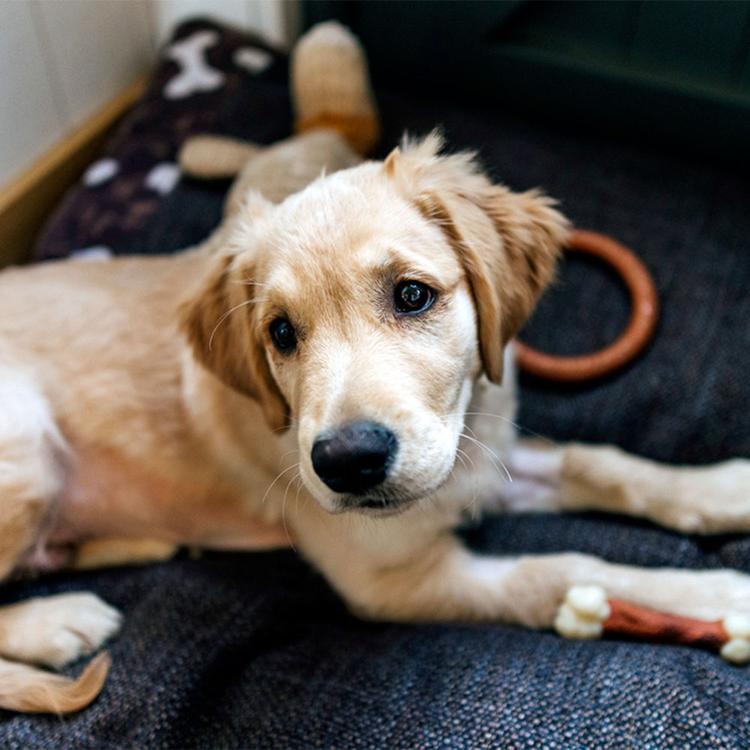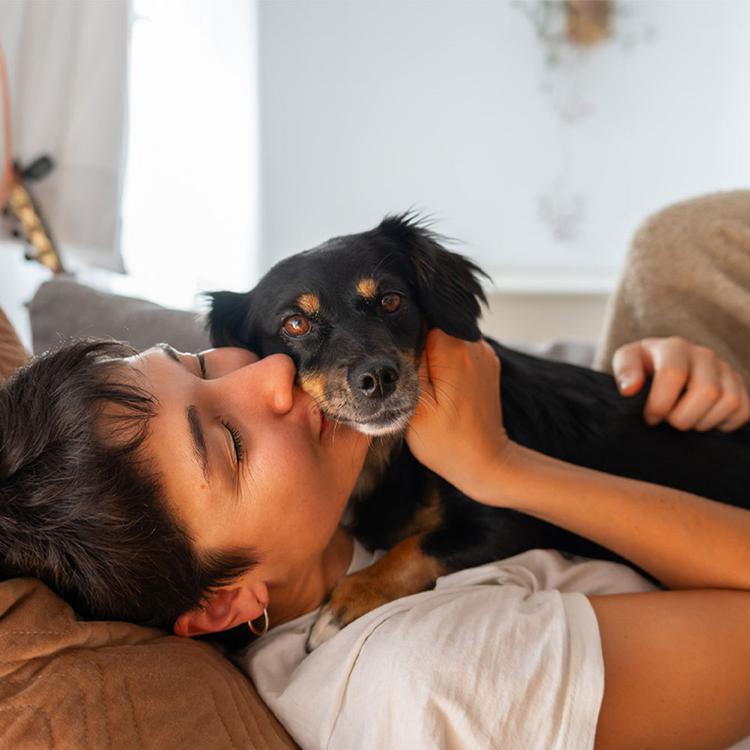Which Dog Collar Is Best for Your New Puppy?
From flat collars to breakaway collars, here’s how to choose the best collar for your dog
From flat collars to breakaway collars, here’s how to choose the best collar for your dog
by Katie Koschalk, | April 26, 2024

PeopleImages.com - Yuri A / Shutterstock
When bringing home a new puppy, one of the first items on your shopping list will be a collar. Yet, with the multitude of dog collar types, materials, and styles available, choosing the best one for your pup can get confusing. It’s not just about finding the right fit for your puppy’s size, it’s also crucial that the collar promotes safety, comfort, and effective training.
Feeling overwhelmed? Fear not! We’re here to break it down for you, making the selection process a walk in the park.
Let’s start by reviewing the most common types of dog collars.
Your basic dog collar is a flat or rolled collar. Typically made of nylon or leather, these collars can be found in a variety of patterns and colors. They fasten with a buckle or snap closure and are suitable for everyday use, with identification tags and the ability to attach to leashes.
Rolled collars are a bit more resilient than flat collars, and hold up better for active dogs. But, because they’re raised off the neck, they can catch on things more easily and cause choking.
Breakaway collars are designed to release under pressure, reducing the risk of choking or injury if the collar gets caught on something, like a tree branch or fence. These collars are especially recommended for puppies or dogs who spend a lot of time outdoors.
Safety collars are designed with reflective materials or LED lights to enhance visibility during low-light conditions or nighttime walks. These collars keep your dog visible to motorists, bicyclists, and pedestrians, reducing the risk of accidents.
GPS collars incorporate GPS tracking technology, allowing you to monitor your dog’s location in real time. These collars are ideal for adventurous or escape-prone dogs. They provide peace of mind since you can quickly locate your dogs if they wander off.
Martingale collars (aka limited-slip collars or Greyhound collars) consist of a flat collar with two loops. The first looks like a traditional nylon collar and wraps around about three-quarters of the width of the dog’s neck. The ends of the first loop connect to another smaller loop (called a “control loop”), which the leash attaches to.
Martingales (when properly fitted and designed) sit high on the neck, avoiding the trachea. If the dog pulls, or you pull the leash to make a correction, the collar will slightly tighten — just enough to get a dog’s attention, but not cause discomfort, pain, or injury. The tightening will also prevent the dog from slipping out of their collar.
This type of collar provides more control without the choking effect of a traditional choke collar, making it a popular choice for training and walking strong-willed dogs. It’s also a good choice for dogs with wide necks and narrow heads, like Greyhounds, Whippets, or Shelties, who may slip out of traditional collars more easily.
Choosing the right collar for your puppy involves more than just picking out something that looks cool (although that’s part of it). It’s important to also consider the following factors to ensure their comfort, safety, and overall well-being.
The size of your puppy is a crucial consideration when selecting a collar. A collar that’s too loose can slip off, while one that’s too tight can cause discomfort or even injury.
Before buying a collar, measure your puppy’s neck circumference using a fabric measuring tape. You can also use a piece of string to wrap around your dog’s neck, mark it at the correct length, and then measure it with a traditional tape measure. Measure this at about the middle of your dog’s neck.
When choosing a collar for your puppy, consider getting one that can adjust a couple of inches bigger to accommodate your puppy in different situations as they grow.
Consider your puppy’s training needs when choosing a collar. For example, a standard flat collar may suffice if you’re focusing on basic obedience training. However, if you’re working on leash training or addressing behavioral issues, you may need a collar with additional control features, such as a martingale collar.
Take into account your puppy’s coat type when selecting a collar. For puppies with long or thick fur, consider collars with a smooth texture that won’t get tangled or caught in their coats. Additionally, adjustable collars are beneficial for accommodating changes in fur thickness as your puppy grows or if they undergo seasonal shedding.
Your puppy’s temperament also plays a role in collar selection. For example, if your puppy is prone to pulling on the leash or escaping from collars, you may need a more secure option, such as a martingale. On the other hand, if your puppy is calm and well-behaved, a standard flat or rolled collar may suffice for everyday use.
Prioritize safety when choosing a collar for your puppy. If your puppy frequently accompanies you on adventures like hikes, is very curious, or is prone to wandering off, a breakaway collar may be a good idea. This type of collar will reduce the risk of choking or strangulation if the collar gets caught on something.
Also, if you frequently walk your puppy at night or in low-light conditions, consider a collar with reflective or LED features to enhance visibility and keep your puppy safe.
Consider the material and durability of the collar. If your puppy is prone to chewing or rough play, nylon and leather collars are popular options known for their durability and comfort. Or, if you have a water-loving dog, opt for a waterproof collar.
One question you may have is whether or not you need a collar and a harness for your new puppy. The short answer is yes — it’s best to have both. But each has different benefits and uses.
Your dog should wear a collar with an identification tag at all times, except when they’re crated, during nighttime sleep, and when you know you’ll be inside the rest of the evening (and the doors leading outside won’t be opened). The ID tag on your dog’s collar is the main way to identify them if they become lost.
For walks, some dog parents choose to attach the leash to the ring on the collar. This option can be more comfortable and less restrictive for your dog. But this option is usually only reserved for well-trained, non-reactive adult dogs who don’t pull during walks.
A dog harness is a piece of equipment that fits around a dog’s torso. Unlike collars, which fit around the neck, harnesses distribute pressure more evenly across the dog’s body, typically around the chest and shoulders. Harnesses come in various designs and materials. They commonly consist of straps, buckles, and attachment points for leashes.
They offer several advantages over collars:
Control: Harnesses offer greater control over your puppy’s movements, making them ideal for dogs who tend to pull on the leash or have a strong prey drive. They provide leverage, allowing you to adjust your puppy’s direction or attention without causing discomfort.
Safety: Harnesses are designed to eliminate pulling on the dog’s neck, reducing the risk of injury or discomfort. Additionally, some harness designs feature padded straps and reflective materials, further enhancing safety by increasing visibility, especially during low-light conditions.
Training assistance: Certain types of harnesses, such as front-clip or no-pull harnesses, can assist with leash training by discouraging pulling behavior and promoting loose leash walking. These harnesses often feature attachment points on the chest or front of the body, allowing you to guide your puppy’s movements more effectively.
If you use a harness for walks, your dog should also wear their collar with ID.
When fitting a collar on your puppy, make sure you can comfortably fit two of your fingers between the collar and your puppy’s neck. The collar should also be easy to rotate around your dog’s neck. This creates a snug fit without being too tight, reducing the risk of choking or discomfort.
Test the collar’s tightness by attempting to slip it off your dog’s neck. It should be snug enough that it cannot be easily removed.
Regularly check your puppy’s collar to ensure it remains comfortable and securely fastened. Look for any signs of irritation, rubbing, or wear and tear, and replace the collar if necessary to maintain your puppy’s comfort and safety.
Puppies grow quickly, so it’s essential to readjust their collars as they get bigger. Ensure the collar remains properly fitted to prevent it from becoming too tight or loose, which can cause discomfort or pose a choking hazard.
Remove your puppy’s collar during sleep and unsupervised times, such as when you leave your puppy in a crate. This is so it won’t get caught on objects or cause injury. This is especially important for puppies prone to chewing or rough play, as collars can pose a choking or strangulation hazard if not used properly. Similarly, you may want to remove them during play to avoid accidents.
Avoid using collars with sharp edges, excessive hardware, or restrictive designs that can cause injury or discomfort to your puppy.
Additionally, prong collars (aka pinch collars), chain slip collars (aka choke collars), and electronic collars (aka e-collars) are now widely discouraged. Fear- or pain-based training methods may have some short-term results, but they can also lead to other canine behavioral problems, such as aggression, phobias, and high levels of stress. In the case of prong collars and choke collars, excessive pulling can cause injuries to the dog’s trachea, esophagus, blood vessels (in the eyes, neck, and nerves), as well as fainting, temporary paralysis, and even death.
Most modern dog trainers recommend positive reinforcement techniques over potentially dangerous tools like choke collars.
In addition to buying your new puppy a collar with ID tags, a leash, and a harness, you’ll also need the following supplies: a dog bed, food and water bowls, quality puppy food, puppy treats, chew toys, grooming supplies, and a crate.
Raising a puppy involves various considerations, including socialization, obedience training, proper nutrition, veterinary care, exercise, and establishing routines. For more in-depth information, check out our guide on raising a puppy.
The best collar for your puppy will depend on your puppy’s size and specific needs. You should also consider the material and safety features. Breakaway collars are recommended for puppies who spend time outdoors, while martingale collars are a good option for leash training.
Psst! Learn about how to find a safe and effective collar for your cat, too.
Choosing the Right Type of Collar for Your Dog
Dog Pulling on the Leash: Effects of Restraint by a Neck Collar vs. a Chest Harness
Should My Puppy Wear a Harness or Collar? Choosing the Safest Option

Katie Koschalk is a freelance writer based in Northern California. Fusing her love and knowledge of animals with her journalism degree and years of professional writing, Katie is dedicated to improving the lives of pets and their caretakers by sharing helpful and accurate information. When she’s not at her desk, you can find her exploring trails with her Aussie, Hunter, cooking plant-based meals, and talking to her two cats, Jax and Sadie, in really ridiculous voices.

Adoption Advice

Adoption Advice

Adoption Advice

Adoption Advice
Did you adopt an old soul? These cute names with vintage vibes are perfect for your pup.

Adoption Advice
Hesitant to adopt a dog? We break down common dog adoption worries and offer practical tips for a smooth transition.

Adoption Advice
From bonding to socializing, raising puppies two puppies at once is a lot of work. Here is what to expect if you decide to get a dynamic duo.

Adoption Advice

Adoption Advice

Adoption Advice
Choosing what breed to adopt? Here are the 10 most popular dog breeds.